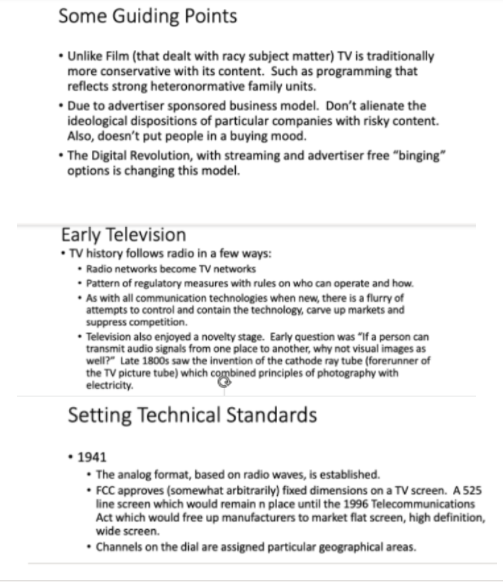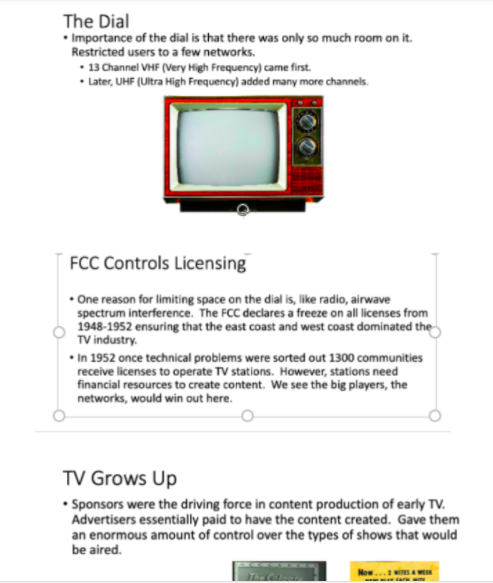I think the answer is d, but I'm not sure if I'm right. Please help. 1. According to the Lesson, what was the business model that emerged as a result of Radio Regulation laws? A. Television technology would set the standard for broadcasting regulations B. Broadcasting would be controlled through a democratic process C. Broadcasting would become a non-profit public service D. The for-profit system of private ownership trumped public access and ownership of the airwaves
I think the answer is d, but I'm not sure if I'm right. Please help. 1. According to the Lesson, what was the business model that emerged as a result of Radio Regulation laws? A. Television technology would set the standard for broadcasting regulations B. Broadcasting would be controlled through a democratic process C. Broadcasting would become a non-profit public service D. The for-profit system of private ownership trumped public access and ownership of the airwaves
Principles Of Marketing
17th Edition
ISBN:9780134492513
Author:Kotler, Philip, Armstrong, Gary (gary M.)
Publisher:Kotler, Philip, Armstrong, Gary (gary M.)
Chapter1: Marketing: Creating Customer Value And Engagement
Section: Chapter Questions
Problem 1.1DQ
Related questions
Question
I think the answer is d, but I'm not sure if I'm right. Please help.
1. According to the Lesson, what was the business model that emerged as a result of Radio Regulation laws?
| A. |
Television technology would set the standard for broadcasting regulations |
|
| B. |
Broadcasting would be controlled through a democratic process |
|
| C. |
Broadcasting would become a non-profit public service |
|
| D. |
The for-profit system of private ownership trumped public access and ownership of the airwaves |

Transcribed Image Text:Some Guiding Points
• Unlike Film (that dealt with racy subject matter) TV is traditionally
more conservative with its content. Such as programming that
reflects strong heteronormative family units.
• Due to advertiser sponsored business model. Don't alienate the
ideological dispositions of particular companies with risky content.
Also, doesn't put people in a buying mood.
• The Digital Revolution, with streaming and advertiser free "binging"
options is changing this model.
Early Television
• TV history follows radio in a few ways:
• Radio networks become TV networks
• Pattern of regulatory measures with rules on who can operate and how.
• As with all communication technologies when new, there is a flurry of
attempts to control and contain the technology, carve up markets and
suppress competition.
• Television also enjoyed a novelty stage. Early question was "If a person can
transmit audio signals from one place to another, why not visual images as
well?" Late 1800s saw the invention of the cathode ray tube (forerunner of
the TV picture tube) which combined principles of photography with
electricity.
Setting Technical Standards
• 1941
• The analog format, based on radio waves, is established.
• FCC approves (somewhat arbitrarily) fixed dimensions on a TV screen. A 525
line screen which would remain n place until the 1996 Telecommunications
Act which would free up manufacturers to market flat screen, high definition,
wide screen.
• Channels on the dial are assigned particular geographical areas.

Transcribed Image Text:The Dial
• Importance of the dial is that there was only so much room on it.
Restricted users to a few networks.
• 13 Channel VHF (Very High Frequency) came first.
• Later, UHF (Ultra High Frequency) added many more channels.
FCC Controls Licensing
• One reason for limiting space on the dial is, like radio, airwave
spectrum interference. The FCC declares a freeze on all licenses from
1948-1952 ensuring that the east coast and west coast dominated the
TV industry.
• In 1952 once technical problems were sorted out 1300 communities
receive licenses to operate TV stations. However, stations need
financial resources to create content. We see the big players, the
networks, would win out here.
TV Grows Up
• Sponsors were the driving force in content production of early TV.
Advertisers essentially paid to have the content created. Gave them
an enormous amount of control over the types of shows that would
be aired.
Expert Solution
This question has been solved!
Explore an expertly crafted, step-by-step solution for a thorough understanding of key concepts.
Step by step
Solved in 3 steps

Recommended textbooks for you

Principles Of Marketing
Marketing
ISBN:
9780134492513
Author:
Kotler, Philip, Armstrong, Gary (gary M.)
Publisher:
Pearson Higher Education,

Marketing
Marketing
ISBN:
9781259924040
Author:
Roger A. Kerin, Steven W. Hartley
Publisher:
McGraw-Hill Education

Foundations of Business (MindTap Course List)
Marketing
ISBN:
9781337386920
Author:
William M. Pride, Robert J. Hughes, Jack R. Kapoor
Publisher:
Cengage Learning

Principles Of Marketing
Marketing
ISBN:
9780134492513
Author:
Kotler, Philip, Armstrong, Gary (gary M.)
Publisher:
Pearson Higher Education,

Marketing
Marketing
ISBN:
9781259924040
Author:
Roger A. Kerin, Steven W. Hartley
Publisher:
McGraw-Hill Education

Foundations of Business (MindTap Course List)
Marketing
ISBN:
9781337386920
Author:
William M. Pride, Robert J. Hughes, Jack R. Kapoor
Publisher:
Cengage Learning

Marketing: An Introduction (13th Edition)
Marketing
ISBN:
9780134149530
Author:
Gary Armstrong, Philip Kotler
Publisher:
PEARSON


Contemporary Marketing
Marketing
ISBN:
9780357033777
Author:
Louis E. Boone, David L. Kurtz
Publisher:
Cengage Learning